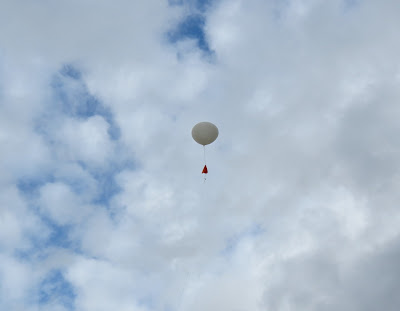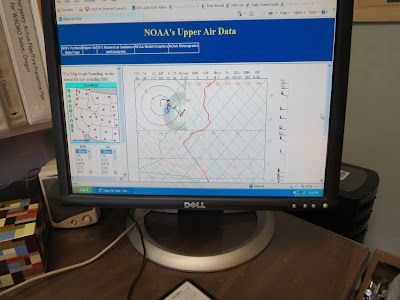Ted Vaughn is owner of a company that has 5 year contracts at 4 or 5 of the 87 sites around the United States that release weather balloons twice a day...once at 4:00 am and again at 4:00 pm. All 87 sites across the country release at the same time. As president of the company he gets to pick which site he'll release from. Ted got his degree in meteorology while in the Navy.
While most of my friends know I am a weather addict, unfortunately this is about the extent of my weather education.
The cardboard box Ted is holding is the key to National Weather Service Center getting current meteorology information from our atmosphere. At $400 a launch, this little box has a GPS chip for altitude, a temperature recorder and humidity sensor. All data is recorded and sent back to Ted once every second.
This building houses the radar that tracks the balloon and is where the balloons are filled.
Most balloons burst at around 90,000 to 100,000 feet. Ted did have one hit a record 131,801 feet before bursting.
Ted fills the balloon with hydrogen, which is flammable, in a completely grounded safe room which even cell phone are excluded.
If the balloon doesn't burst, or comes down unexpectedly, there are warnings for any unaware people to be careful of the material.
Damn it! Because I was doing the photos, Donna got to release the balloon...and she did a good job of it too:-) The orange cloth attached to the balloon is a parachute. The control box is hung another 100 feet below the parachute...nearly all are made of environmentally friendly (biodegradable) products.
After Ted called the tower and got the ok for the flight, off goes balloon "Donna", rising at 1000 feet per minute for it's expected 90 minute flight.
By the time it hits 90,000 feet this balloon will have increased in size to about as big as a house.
Now it is back to the office to start collecting the data that will be released to the National Weather Service. After all the information is downloaded and then "cleaned up" by Ted, it is then uploaded to NWS.
Below is one of the many grafts Ted must interpret before sending along. Far line on the left shows the steady rise of the balloon. The middle line is temperature and the far right is the humidity. An example of "cleaning up" is, while rising through a cloud, if water gets on the humidity sensor and it freezes, the info would be corrupt and this is part of the "cleaning up" of the data that Ted must do.
Many thanks to Ted for his time and consideration in explaining the inner workings of his weather balloon company. We now have a much better understanding how weather is reported.
,













2 comments:
Whoa Tom.... this must have been one of your best stops so far. I would love to have Ted's job. Never thought weather balloons could be so cool.....
Jack
You guys are learning so much! Does your brain ever feel like it's going to explode? :-) Very cool....as usual!
Post a Comment